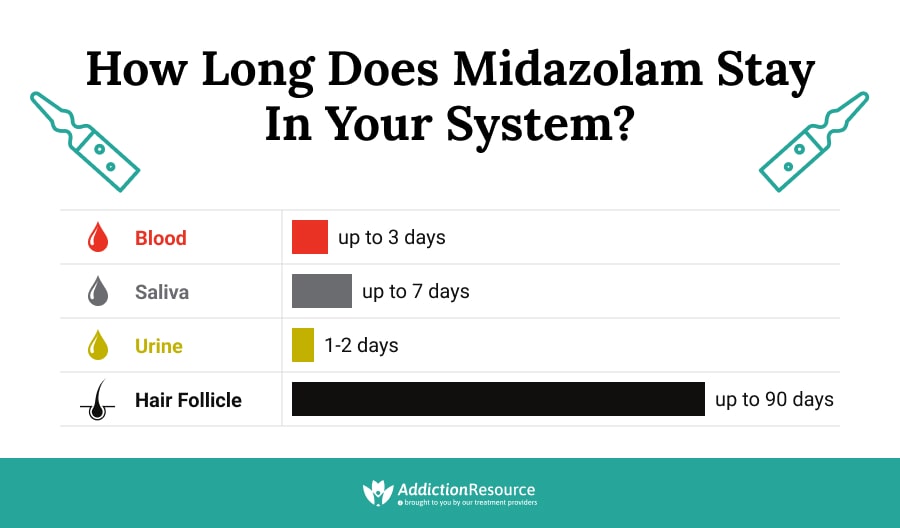Midazolam drug is commonly used by doctors during procedures to sedate patients and to relieve their anxiety and agitation. Benzodiazepines are safe and effective if used properly. However, it is important to know that inappropriate use of this drug and long-term use of it causes dangers to health. This product has a high potential for misuse, abuse, dependence, and addiction. In this article, information about the product’s category, dosage, mechanism of action, side effects, dangers, and overdose treatment options will be provided.
Table Of Contents:
- What is Midazolam?
- Midazolam Dosage Forms and Strengths
- Benzodiazepines Mechanism of Action
- Midazolam Side Effects
- Indication and Risks of Addiction
- Who is Most at Risk of Midazolam Addiction?
- Midazolam Abuse Statistics
- Signs and Symptoms of Benzodiazepine Abuse and Addiction
- Possible Dangers of Benzodiazepine Abuse
- Benzodiazepines Contraindications and Warnings
- Midazolam Onset, Duration, Half-Life, and How Long it Stays in the System
- Benzodiazepines Addiction Treatment

If a person uses Midazolam Versed for an extended period, there is a high percentage of developing high tolerance.
More About Benzodiazepines:
What is Midazolam?
Classified under the group Benzodiazepines, this drug is used as anesthesia and as an emergency treatment for seizures. It is the generic name of Dormicum, Hypnovel, and Versed. Also, this medication is considered a prescription drug. Compared to other prescription drugs, Benzodiazepines are highly addictive and are prone to be misused and abused. These medicines are listed as Essential Medicines by the World Health Organization. Since it is a very powerful one, it is also considered as a controlled substance. Thus, it should be used only in hospital or ambulatory care settings.
Midazolam Dosage Forms and Strengths
To identify the dosage form and strength to be used, a physician considers the age and weight of the patient. Thus, Midazolam uses are always determined by the doctor.
The Medication Is Available In the Following Dosage Forms and Strengths:
- Syrup (2mg/mL)
- Tablet (15mg)
- Nasal spray (0.5mg, 1.25mg, and 5mg/mL)
- Injection (5mg/mL, 5mg/5mL, and 15mg/3mL)
Aside from the age and weight, the dosage form and strength to be used will also depend on a patient’s health and condition. For example, an older patient might be prescribed a syrup if the patient is unable to swallow tablets.
Benzodiazepines Mechanism of Action
Like the other Benzodiazepines, this anesthesia binds with the GABA receptor in the brain. For the brain to function properly, inhibition and excitation should be balanced and this balancing activity is done by the GABA receptor. When the drug is bound with the GABA receptor, there will be a promotion of sleep because the former will help the receptor to focus more on its inhibiting activity. Eventually, the benzodiazepine will cause muscle-relaxing effects after acting on glycine receptors in the brain.

Midazolam Side Effects
The side effects of this medication depend on the number of doses and dosage strengths that have been used. Additionally, the side effects of this drug may be divided into three parts: common, severe, and long-term side effects.
Common Short-Term Side Effects
Common side effects of Benzodiazepines happen to a handful of people. The common short-term side effects of this anesthesia may last up to two days.
These Common Side Effects Include the Following:
- Noisy breathing
- Slurred speech
- Difficulty in speaking
- Restlessness
- Headache
- Lack of balance
- Irritability
Everyone has a different body complexity and this is the reason why some may experience these common side effects while some others may not. Although the side effects mentioned above are common, it is important to talk about them with a healthcare provider if they happen.
Severe Side Effects
Severe side effects occur when a patient has used a larger dose of the medication than prescribed or when a patient has used the product without a prescription.
Severe Side Effects of This Medicine Are the Following:
- Tremors
- Loss of consciousness
- Unexplained drowsiness
- Difficulty with coordination
In Rare Cases, Other Severe Side Effects Are the Following:
- Blurry vision
- Double vision
- Hiccups
- Drooling of mouth
- Gagging
- Not breathing
- Hallucinations
It is important to recognize the side effects of this medication. If a person suspects someone with the severe side effects listed above, immediate medical assistance must be given.
Long-Term Side Effects
When a patient has used Midazolam Versed for a longer period of time, this may cause long-term side effects.
These Long-Term Side Effects May Lead to Serious and Dangerous Situations Such As:
- Respiratory depression
- Respiratory arrest
- Acute withdrawal symptoms
- Dependence
- Addiction
When the brain is repeatedly exposed to this anesthesia, this drug can cause changes in the functions of the brain. Therefore, it is important to always follow the instructions or advice of a doctor.
Although short-term use of this benzodiazepine with strict medical professional supervision is safe, long-term use of this drug may cause misuse and addiction.
Indication For Use, And Risks of Addiction
Midazolam uses vary, and it is prescribed depending on the case of the patient. Presently, Midazolam Versed is prescribed as anesthesia to sedate patients who are about to undergo medical procedures like pregnancy surgery. Additionally, doctors also give this drug to treat other conditions such as anxiety. However, this drug is given under strict supervision as it can cause breathing problems. Below are other Midazolam uses:
- Used to treat symptoms of Status Epilepticus
- Used to manage insomnia
- Anticonvulsant
- Used to relax muscles
If a person uses Midazolam Versed for an extended period, there is a high percentage of developing high tolerance. According to a study, a single dose of Midazolam Versed will not show any withdrawal signs but continuous use of it might cause dependence and addiction.
Who Is Most at Risk of Midazolam Addiction?
Like the other Benzodiazepines, this product has the potential for abuse. Thus, it can be considered addicting. Although short-term use of this benzodiazepine with strict medical professional supervision is safe, long-term use of this drug may cause misuse and addiction. Therefore, individuals who use it longer than prescribed are at most risk for addiction. Also, individuals who use this product without a prescription, use it recreationally, and use it along with other drugs or alcohol are at risk for Midazolam addiction.
Midazolam Abuse Statistics
The longer someone uses Benzodiazepines the more likely dependence, abuse, and addiction may occur. According to a study, there is a high rate of Midazolam abuse in Thailand. In this study, almost 57% of the participants reported that they had used the medicine on a daily basis. In 2017, it was reported that almost 5.4 million individuals in the United States used this product inappropriately. These individuals are of ages 12 years old and above.

Signs and Symptoms of Benzodiazepine Abuse and Addiction
Midazolam abuse affects the career, relationship, physical, and mental health of a person. Below are the psychosocial, behavioral, and physical signs and symptoms of Midazolam addiction:
Psychosocial and Behavioral Signs
Drugs abuse and addiction shift a person’s attitude from great to undesirable characteristics. For some people, mental illness signs may be seen after Midazolam addiction.
Below Are Some Psychosocial and Behavioral Signs of a Patient With Midazolam Abuse or Midazolam Addiction:
- Withdrawal from friends and families
- Negligence from obligations in order to have time to use the drug
- Fearful of the place where there is no supply of the drug
- Brave enough to do illegal activities just to be able to play for the drug
- Engages in risky activities after using the drug
- Exhibits no effort in showing care for self or grooming
- Becomes secretive
- Easily changes mood
Benzodiazepines work in the brain and anytime this product is used outside the instruction of a doctor, that is considered as Midazolam abuse. Therefore, it should not be taken without a doctor’s supervision as this can lead to addiction.
Physical Signs
Aside from behavioral signs and symptoms, physical changes in association with Midazolam abuse and Midazolam addiction are the following:
- Physical weakness
- Lack of motor coordination
- Slurred speech
- Inability to defend self
Untreated misuse and addiction to this drug may lead to many complications such as family problems. Also, abuse of this product may cause a person to become dependent on it which might lead to the physical changes mentioned above.
A sudden stop in the usage of this product or other Benzodiazepines may cause undesirable withdrawal symptoms. The length of detoxification treatment will depend on how long a patient has been using the Midazolam drug.
Possible Dangers of Benzodiazepine Abuse
Midazolam addiction and Midazolam abuse may cause dangers such as shallow breathing and even death. Additionally, suddenly stopping this medication after using it for a longer period of time and at a higher dose may cause withdrawal symptoms such as restlessness. Below is the information regarding overdose, withdrawal, and interactions:
Overdose
Overdose of this product may cause intense, dangerous effects including coma and death. These dangerous events happen because a patient experiences respiratory depression. Even at a therapeutic, decent dose, when it is used with other central nervous system depressants, a patient may experience death.
Withdrawal
Aside from using this drug for a longer period of time, withdrawal occurs when a patient takes higher doses of this medicine than prescribed and then quits abruptly.
Below Are the Withdrawal Symptoms That Could Be Visible:
- Rapid heartbeat
- Hallucinations
- Muscle pain
- Seizures
- Stomach cramps
- Sweating
- Body tremors
- Nausea
- Vomiting
According to a study, individuals who experience withdrawal syndrome are having life-sustaining treatment in the hospital ICU and it takes only up to 57 days for them to stay alive if their respiratory system fails to get breathing support.
Benzodiazepines Drug Interactions
Drug interactions affect how a certain medicine works. There are many different drug classifications such as major, moderate, minor, and unknown interactions. Below are some examples of drugs or products that might interact with this Benzodiazepine.
Major Drug Interactions
When taken with protease inhibitors, prolonged sedation and an increase in length of hospital stay may happen. Examples of these protease inhibitors are HIV drugs such as ritonavir. Also, taking it with antifungals increases the sedation effects of benzodiazepine. An example of these antifungals is Ketoconazole.
Moderate Drug Interactions
When taken with antihistamines, there is a risk of an increase in drowsiness. An example of these antihistamine drugs is Benadryl.
Minor Drug Interactions
When taken with antacids such as Aluminum hydroxide, minor drug interactions may occur such as delay in the gastrointestinal absorption of the benzodiazepine. An example of these antacid drugs is the brand name Maalox.
Unknown Drug Interactions
There is an unknown interaction when this product is taken together with Paracetamol. For this, it might be safe when taken together. However, it is still important to reach out to a healthcare provider before taking other products when taking this medicine.
To minimize and avoid drug interactions, it is important to communicate with a pharmacist.

Benzodiazepines Contraindications and Warnings
Contraindications and warnings such as present health conditions are important things to be noted when taking any medicine. It is important to note the information below in order to optimize the medical use of the benzodiazepine product:
Contraindications
The drug is contraindicated in patients with the following conditions:
- Known hypersensitivity to the drug
- Patients with acute narrow-angle glaucoma
- Patients with hypotension
Careful dosage adjustment is needed for the following:
- Patients with kidney and liver disease
- Alcohol and drug-dependent individuals
Warnings
Caution is necessary for the following when taking the medicine:
- Women who are pregnant, planning to conceive, or breastfeeding
- Individuals diagnosed with psychosis
- Taking other medicines, health or dietary supplements and products
- Currently experiencing breathing problems like COPD and Open-angle
- Have acquired blood disease porphyria
It is important to talk with a healthcare provider in case a patient is having any of these contraindications and warnings as these will affect the nature and effect of the drug.
Midazolam Onset, Duration, Half-Life, and How Long it Stays in the System
The onset of action is the time for Benzodiazepines to show their effect while the duration of action is the time until when a drug is effective. On the other hand, half-life means the time for a drug to decrease its concentration by half. In the information below, the onset, duration, half-life, and how long it stays in the system (urine, blood, saliva, and hair) will be provided:
Onset And Duration of Action of Action
Oral administration only takes 5 to 10 minutes for it to work and when administered via injection route, this product will work within 2 to 5 minutes. Lastly, when administered via spray route, it works within 3 to 4 minutes. Midazolam duration of action is short (10-15 minutes) when given via oral route and for the injection route, its duration of action lasts for 1 to 1.5 hours. Lastly, if administered via spray route, Midazolam duration of action lasts for 15-45 minutes.

Half-Life
The elimination half-life of this drug is the same for the oral and injection routes. Moreover, this drug has an average half-life of 2.3 hours. However, this half-life may be prolonged in patients with renal or hepatic problems.
Midazolam in the Urine, Saliva, Hair, and Blood
Long-acting and short-acting Benzodiazepines differ when it comes to the number of hours they stay in the urine. In this information table, it can be detected in the urine for up to 2 days. For the saliva, like other benzodiazepines, this product can be detected for up to 7 days. Moreover, the metabolites of Midazolam pills appear in the hair roots even after just a single dose. Within 5 minutes, its metabolites will start to enter the hair roots. Washed or unwashed, it can be detected in the hair for up to 3 months. When it comes to the presence in the blood, testing benzodiazepines using blood provides an accurate result. Midazolam pills can be detected in the blood for up to 3 days after the last dose.
Benzodiazepines and Drug Test
False-positive Midazolam drug test results can lead to serious medical and social concerns. There are many instances when a person is asked to submit a drug test such as when that person is applying for a job. According to a study, there is a 2.2% chance of getting a positive drug test result when a patient is taking Midazolam drug. Additionally, this drug is tested on a 12-panel drug test on a detection window of 1 to 7 days. This drug test uses urine or hair follicle to test the presence of Benzodiazepines.

Benzodiazepines Addiction Treatment
Getting the right support and health treatment will give hope to those people who want to go out of this addiction. Below are some treatments and support programs:
Detoxification
A sudden stop in the usage of this product or other Benzodiazepines may cause undesirable withdrawal symptoms. For this reason, it is important to follow the detoxification process. During the detoxification process, there will be tapering down of dosage. Additionally, other medications and appropriate treatments will be given as support in order to minimize some withdrawal symptoms. The length of detoxification treatment will depend on how long a patient has been using the Midazolam drug.
Antidote
Flumazenil is the drug that is considered as a Midazolam antidote. It is effective in reversing the effects of Midazolam and other Benzodiazepines. According to a study, this Midazolam antidote is safe to use and causes no risks.
Drug Rehabilitation Programs
Drug rehabilitation programs are another way to treat any benzodiazepines addiction and abuse. Interestingly, drug rehabilitation can be categorized as in-patient or out-patient. On these programs, a patient will work with medical doctors, addiction treatment specialists, and clinical therapists where lectures about health, drugs, and recovery will be given. Additionally, teaching or enhancing life skills and behavior will be provided.
Sober Living and Aftercare Programs
After drug rehabilitation, a patient recovering from benzodiazepines addiction and abuse may consider enrolling in sober living programs. These programs provide continuous recovery support and care. Meetings may be once a week or depending on the program a patient has chosen. Usually, sober living programs are done in residential neighborhoods while aftercare programs are kind of clinical settings but out-patient ones.
Hope Without Commitment
Find the best treatment options. Call our free and confidential helpline
Most private insurances accepted
Page Sources
- Ahonen, J., Olkkola, K. T., Takala, A., & Neuvonen, P. J. (1999). Interaction between fluconazole and midazolam in intensive care patients. Acta anaesthesiologica scandinavica, 43(5), 509-514.
- Ashton H. (1994). The treatment of benzodiazepine dependence. Addiction. Society for the Study of Addiction, 89(11), 1535-41.
- Bertholf, R. L., Sharma, R., & Reisfield, G. M. (2016). Predictive value of positive drug screening results in an urban outpatient population. Journal of analytical toxicology, 40(9), 726-731.
- Boisse, N., Quaglietta, N., Samoriski, G., Guarino, J. (1990). Tolerance and physical dependence to a short-acting benzodiazepine, midazolam. Journal of Pharmacology and Experimental Therapeutics, 252(3), 1125-33.
- Borbély, A. A., Balderer, G., Trachsel, L., & Tobler, I. (1985). Effect of midazolam and sleep deprivation on day-time sleep propensity. Arzneimittel-forschung, 35(11), 1696-1699.
- Chan, J. D., Treece, P. D., Engelberg, R. A., Crowley, L., Rubenfeld, G. D., Steinberg, K. P., & Curtis, J. R. (2004). Narcotic and benzodiazepine use after withdrawal of life support: association with time to death?. Chest, 126(1), 286-293.
- Chokshi, A. A., Patel, V. R., Chauhan, P. R., Patel, D. J., Chadha, I. A., & Ramani, M. N. (2013). Evaluation of intranasal midazolam spray as a sedative in pediatric patients for radiological imaging procedures. Anesthesia, essays and researches, 7(2), 189.
- Driessen, J. J., Vree, T. B., & Guelen, P. J. (1991). The effects of acute changes in renal function on the pharmacokinetics of midazolam during long-term infusion in ICU patients. Acta Anaesthesiologica Belgica, 42(3), 149-155.
- Griffin, C. E., Kaye, A. M., Bueno, F. R., & Kaye, A. D. (2013). Benzodiazepine pharmacology and central nervous system-mediated effects. Retrieved May 4, 2021, from https://www.ncbi.nlm.nih.gov/pmc/articles/PMC3684331/
- Hayashi, K., Suwannawong, P., Ti, L., Kaplan, K., Wood, E., & Kerr, T. (2013). High rates of midazolam injection and associated harms in Bangkok, Thailand. Harm Reduction Journal, 108(5), 944–952. https://doi.org/10.1111/add.12094
- Henthorn, K. M., & Dickinson, C. (2010). The use of flumazenil after midazolam-induced conscious sedation. British dental journal, 209(11), E18-E18.
- Michalodimitrakis, M., Christodoulou, P., Tsatsakis, A. M., Askoxilakis, I., Stiakakis, I., & Mouzas, I. (1999). Death Related to Midazolam Overdose During Endoscopic Retrograde Cholangiopancreatography. The American Journal of Forensic Medicine and Pathology, 20(1), 93–97. https://doi.org/10.1097/00000433-199903000-00022
- Ng, W. L., Mythily, S., Song, G., Chan, Y. H., & Winslow, M. (2007). Concomitant use of midazolam and buprenorphine and its implications among drug users in Singapore. Annals-Academy of Medicine Singapore, 36(9), 774.
- Prommer, E. (2020). Midazolam: An essential palliative care drug. Palliative Care and Social Practice, 14, 263235241989552, https://pubmed.ncbi.nlm.nih.gov/32215374/
- Shon, N. N., Yarbrough, T., & Shah, A. D. (2019). Aluminum Hydroxide. Retrieved May 4, 2021, from https://www.ncbi.nlm.nih.gov/books/NBK546669/

 Authored by
Authored by  Reviewed by
Reviewed by 

